WASHINGTON—A state-sponsored Chinese dance company touring the Eastern United States includes classical dance, “cutting-edge” new works, and a twist of unexpected Maoist revivalism.
That last part is not on the website of the Beijing Dance Company, nor in the program booklet, nor announced anywhere in the performance itself—but the triumphant strains of Mao Zedong’s theme song, “The East is Red” are unmistakable at the finale of the two-hour performance. Red lights bathe the stage, and the dancers leap for joy at the prospect of the communist “liberation” of China.
Including a positive depiction of the Communist Party’s rule is an important element of Beijing’s cultural outreach in recent years, according to experts and Party documents. The regime is seeking to convince the West of its legitimacy through a vast array of initiatives, including song and dance performances like this, these experts say.
The transition from contemporary Chinese dance to Maoist paean takes place at the very end of a longer song called “Yellow River.” This version of that song, which incorporates “The East is Red,” dates back to the Cultural Revolution.
The English-language program booklet only highlights the traditional nature of the “Yellow River,” without explaining the red-colored climax. Western audience members would not have known that’s what they were seeing unless they were familiar with decades old Chinese communist songs.
But practically every Chinese is familiar with the tune, according to Hong Mautz, president of Chinus Cultural Communications, the promoter of the show.
She also explained how the two songs complement each other.
“The Yellow River has been witness to so much suffering of the Chinese people, the ebb and tides,” she explained after the performance on Nov. 17 at the Kennedy Center in Washington.
“Finally, Mao came and reunited China and established the New China. ... He showed the future,” she added.
That’s when the lights went red and the music changed.
During the interview Mautz hummed the tune to “The East is Red.” She had grown up with it. It was not clear whether she was aware that Mao’s political campaigns in China during the late 1950s and early 1960s led to at least 60 million deaths.
A graduate of the Beijing Dance Academy who was in the audience said after the show that she suspects only Chinese people would have understood what had just taken place on stage, as there were no lyrics or accompanying explanation.
She said she felt uncomfortable with the political content.
Chen Kuide, executive director of the Princeton China Initiative and publisher of the online magazine China In Perspective, said that the way the Maoist message appeared only at the end of the performance is a good demonstration of the “united front” strategy, which dates back to the days of Mao Zedong and Zhou Enlai, the communist regime’s first foreign minister.
This strategy seeks first to create friends before real motives are revealed. “They use traditional, innocuous things that people can accept. ... Then gradually they want to explain the legitimacy of their regime, to put in their real ideological message,” he said.
He explained in a telephone interview that if overseas performing troupes immediately jumped into explications of Mao Zedong thought and the Party’s ruling ideology, “it would fail immediately.”
Robert Russo, Mautz’s co-promoter with Chinus Cultural Productions, was unaware that the song performed at the end was in fact “The East is Red.” In a later telephone interview he said that he disagrees with any notion that the performance contained a political message. “I don’t think there was a hidden agenda to create a message there. I can’t speak to the people who created the ballet,” he said.
The Chinese regime is forking out a lot of money for performing arts troupes like the Beijing Dance Company to tour the world. According to the new book “China’s Thought Management,” edited by Anne-Marie Brady, a political scientist focused on Chinese propaganda, the Chinese regime has over the last couple of decades made a concerted effort to enhance its control over the cultural sector.
This includes funneling money into cultural enterprises that are controlled or managed by the state, in order to contain and crowd out independent, private cultural groups that had previously made inroads.
The Beijing Dance Academy, founded in 1954, is the only professional accredited institution of higher education in dance in China. The Beijing Dance Company, which is its touring arm, was founded in 1987.
The current tour is being sponsored by the China Arts and Entertainment Group and Image China, both of which are Party initiatives to export the officially sanctioned version of Chinese culture—and its unexpected accoutrements—to the world.
The effort fits into the broad external propaganda framework set down by Party central in recent years.
According to Brady’s book, the regime has placed increasing emphasis on the role of culture to promote China’s national image. “The new image aims to allay international fears about China’s increasing political, economic, and military power,” she writes.
Mautz explained that Chinus is trying to make the Beijing Dance Company into a “big brand,” because there are no other Chinese touring companies with name recognition in the West. She said the performances were meant to represent the “new China,” referring to when economic reforms began in 1978—despite the Maoist imagery at the end.
The confused nature of the messaging is not surprising to Chen Kuide. “It’s a bit of a mix, it looks rather unclear, but actually they are making their voice very clear. They want to open the market, put their message out innocuously, and once they’re in they will show their true face,” he said.
The most important thing for the regime in China is its ruling legitimacy to the Chinese people, Chen explained. “But if it can’t get any support or cooperation internationally, they'll lose their persuasive power to the Chinese people,” he said. “So its legitimacy is what it most pursues.”





Friends Read Free